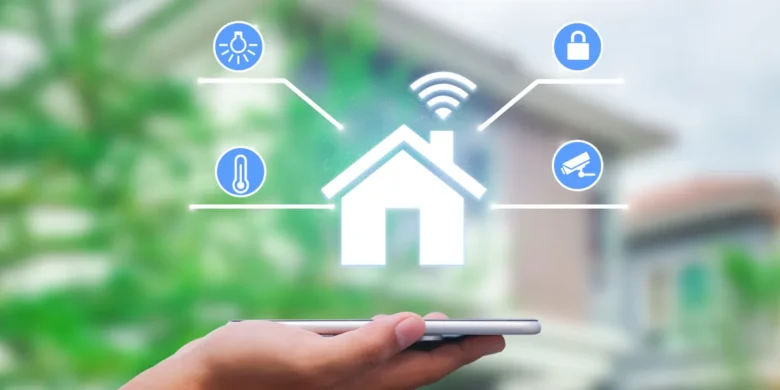No matter where you are in your home or work life, smart home devices offer remote solutions for greeting guests via video doorbell or managing lights remotely, such as Alexa and Google Assistant voice assistants. Selecting the ideal device to manage your smart home is of utmost importance, and we suggest starting off with either a smart speaker or display that can manage various connected gadgets from different brands using one app.
1. I Want Security
Smart homes can detect and respond to an array of environmental conditions. A smart home can turn on its lights when the doorbell rings, notify you if smoke or carbon monoxide levels rise too high, call emergency services on its own, and even call fire brigades automatically.
Security systems provide homeowners with additional peace of mind by notifying them when motion is detected or an attempted break-in takes place. They can even remotely unlock doors and illuminate pathways toward safety. If you’re thinking of upgrading to a smart house, begin by identifying your needs. Decide which areas of your home you wish to automate first and start working on those first.
2. I Want Convenience
As smart devices become more widespread, consumers are looking for ways to maximize convenience—meaning streamlined setup and easy access to their connected home gadgets. Major tech brands are working towards this end by improving software integrations between systems, making it possible for you to control all of your smart devices from one app or voice assistant platform.
Voice and gesture control features allow for effortless operation of routines with one action, such as clapping to turn on lights or pointing at something in order to pause a movie, making smart homes more accessible for individuals with limited mobility.
3. I Want Energy Efficiency
Smart devices can streamline your daily routine in many ways—streaming music, delegating tasks to your virtual assistant, and remotely controlling lighting can all make life simpler and help save energy by turning off lights when no one is home, triggering appliances to run at lower speeds or off altogether, or running your dishwasher during less energy-consuming hours.
Smart home devices connect wirelessly, using protocols like Wi-Fi, Bluetooth, Z-Wave, Zigbee, and more. Before adding any smart devices, ensure your WiFi can support information sharing effectively by upgrading it first.
4. I Want Automation
Automation isn’t a passing trend; it’s an essential tool for businesses looking to scale and remain agile. Automation involves turning tasks into systems that run autonomously without human interference, freeing up more time and energy for creative or critical work. From Siri managing our schedules and reminders to industrial robots assembling cars, automation has become an integral part of everyday life in some form or another. Magical is here to assist business owners in finding the appropriate processes to automate and learning how to get started here. Need some additional resources? Check out our best processes to automate the guide.
5. I Want Control Over My Home
Controlling your home remotely with smart devices can be made simpler than ever, such as video doorbells that let you see who’s at the door before opening it or provide you with advance warning when someone arrives home early.
Other devices can help conserve energy by switching off lights in rooms not in use or instructing power-hungry appliances to shut off on schedule or alerting you if something goes amiss (e.g., security alarm or water leakage), no matter where they may be installed. Some can even notify you remotely should anything go amiss, like a security alarm or water leakage, no matter your location. Many devices communicate through an app on your smartphone or tablet, while others use digital assistants or home hubs such as Amazon Alexa, Apple HomeKit, Samsung SmartThings, or Google Assistant for voice activation.
6. I Want Peace of Mind
Smart home gadgets offer peace of mind. By automating tasks and streamlining daily routines, they enable you to focus more time on doing what matters to you and less on mundane chores.
Smart displays serve as a central hub that lets you control all of the connected devices with just one command. Furthermore, these smart displays show relevant device data such as current temperatures or battery levels, providing valuable insight. A smart home control panel is a custom-installed device that enables you to easily manage locks, thermostats, and other gadgets from a central interface. Compatible with Alexa, Google Assistant, and Apple HomeKit.
7. I Want a Healthy Home
A smart home is an ecosystem of connected devices such as lights, door locks, and appliances such as refrigerators that can be remotely managed through one centralized system. These can either be wireless or hardwired systems using various communication protocols like Wi-Fi, Z-Wave, Bluetooth, and Zigbee.
Devices from Belkin WeMo can be combined together to automate processes and create an “automated recipe.” For instance, you could set one up so your lights come on when someone rings the doorbell or when the air filter needs replacing; you’d also get alerts on your phone in case anything unexpected goes wrong in your house, such as water leakage or an open garage door.
9. I Want a Healthy Life
Imagine living in a home that automatically deodorizes and cleans surfaces, adjusts lights to mimic sunrise, and helps you get quality restful sleep every night. Smart sleep trackers and light switches can help ensure you achieve quality rest for a long, joyful life.
Smart fitness and wellness devices promote physical activity through features like built-in exercise tracking and personalized workout routines; health data analysis and integration with virtual assistants can help manage diet, while refrigerators and kitchen scales make shopping and meal prep simpler. Energy- and water-saving smart appliances can reduce both your carbon footprint and utility bills, as well as come equipped with features designed to ensure optimal indoor climate and air quality.




